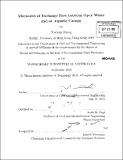Mechanics of exchange flow between open water and an aquatic canopy
Author(s)
Zhang, Xueyan, Ph. D. Massachusetts Institute of Technology
DownloadFull printable version (10.46Mb)
Other Contributors
Massachusetts Institute of Technology. Dept. of Civil and Environmental Engineering.
Advisor
Heidi M. Nepf.
Terms of use
Metadata
Show full item recordAbstract
The presence of aquatic vegetation is a common feature in shallow water systems. It alters the dynamics of the system by producing additional drag and by generating differential heating between regions of vegetation and open water through the shading it provides. The differential heating creates density differences that drive flow between vegetated and open regions. This thesis presents a series of experiments that explored the magnitude and structure of these exchange flows for different forcing and vegetation distributions. The first project considers emergent vegetation with flow forced by a constant density difference. After a short inertial period, the discharge is controlled by the vegetative drag, and the current entering the vegetation, as well as the total discharge, decrease with time. The toe velocity of the current moving into the open region is controlled only by inertia and is constant in time. The second project considers emergent vegetation with a temporally increasing density difference, which was generated by a constant heat input. In the vegetated region, both the buoyancy and vegetative drag experienced by the intruding current increase linearly in time, offsetting on another and resulting in a current velocity moving into the vegetation that is constant in time. The thickness of this intruding layer is set by the length scale of light penetration. The third project considers a mat of floating vegetation whose roots penetrate a fraction of the water depth. The flow was driven by a constant density difference (constant g'). The flow entering the vegetated side bifurcates, with some flow moving through the root layer and the remaining flow displaced downward beneath this layer. The fraction of flow going through and beneath the root layer is allocated such that the conversion from potential energy to kinetic energy is maximized in the system. Finally, this work shows that thermally-driven exchange flow can flush a significant portion of a vegetated sidearm during a diurnal cycle and thus can play a crucial role in the mass balance and distribution in a natural water body.
Description
Thesis (Ph. D. in Environmental Fluid Mechanics)--Massachusetts Institute of Technology, Dept. of Civil and Environmental Engineering, 2010. Cataloged from PDF version of thesis. Includes bibliographical references (p. 121-126).
Date issued
2010Department
Massachusetts Institute of Technology. Department of Civil and Environmental EngineeringPublisher
Massachusetts Institute of Technology
Keywords
Civil and Environmental Engineering.